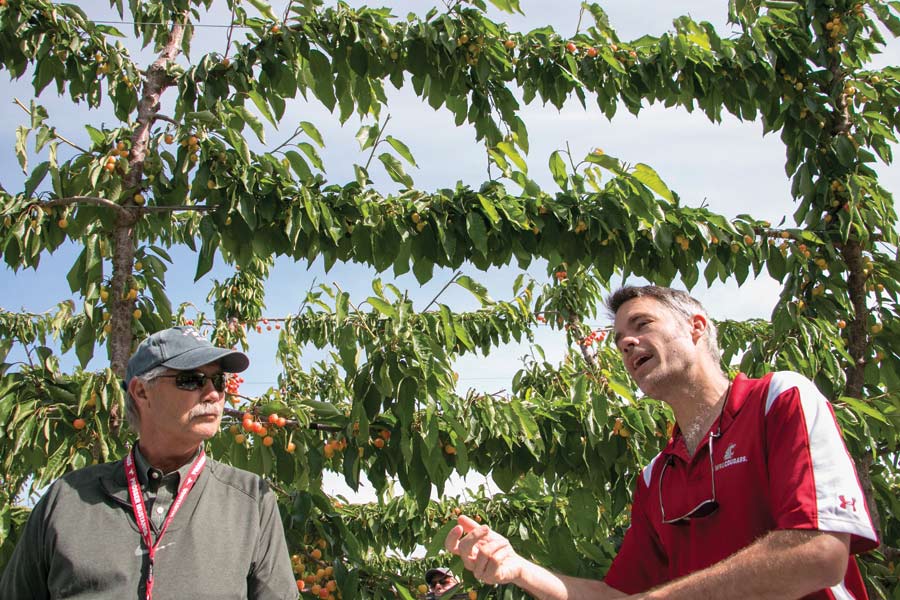
Matt Whiting, right, Washington State University research horticulturist, discusses the intricacies of raising the Early Robin cherry variety with grower Denny Hayden during a May tour in Pasco, Kennewick and Benton City, Washington. The Early Robin is one of the first blush varieties to ripen and is rising in popularity. (Ross Courtney/Good Fruit Grower)
Growers wanting to offer an early blush cherry usually turn to Early Robin.
Early Robin, the only unrestricted early yellow variety, is one of the most requested varieties at nurseries.
Competing varieties are usually associated with a club, but any grower willing to pay the royalties can buy Early Robins.
However, the popular variety, which ripens roughly a week ahead of the lucrative Rainier, has some unique growing quirks.
“It’s on a real sharp incline,” said Matt Whiting, a Washington State University horticulturalist, on a May tour of three Early Robin orchards. “And at the same time, I think a lot of you guys know, you’re recognizing some challenges with the cultivar.”
For one thing, it produces low yields.
Pasco, Washington, grower Denny Hayden anticipated between 5 and 6 tons per acre in his fourth-leaf block, the tour’s first stop. By Early Robin accounts, that would be a good year. The Sweetheart variety, on the other hand, routinely produces 10 to 12 tons per acre or even more, Whiting said.
Early Robins bloom like crazy, but the ovules have a short window of viability that leads to a low rate of fruit set, Whiting warned. All those blooms set growers up for frustration when yields turn out low.
“These things have copious amounts of blooms and they’re popping flowers for a week, even on a year like this,” Hayden said. He applies ReTain (aminoethoxyvinylglycine) at 10 percent to 20 percent bloom to try to extend the pollination window and augments honeybee pollination with dusters.
Early Robins also struggle with mysterious spots of blind wood, especially close to the trunk on his V-trellis trees, Hayden said. He tried cutting way down on his growth regulator Promalin (gibberellins and benzyladenine) rates to no avail.
“It’s an odd phenomenon,” he said.
Compared to other varieties, the Early Robin tends to throw a high percent of floral buds at the base of new shoots, Whiting said. The next year, those end up as blind wood.
Overhead cooling for bloom?
Kennewick grower Todd Wilmoth, the tour’s second stop, also struggled with blind wood but was more frustrated with inconsistent fruit set, especially in warm weather during bloom.
“I can’t figure out why it doesn’t set,” Wilmoth said. He said he might try overhead cooling at bloom time.
That could backfire because water on the flowers may reduce the viability of pollen, Whiting warned. Whiting also advised against under-canopy cooling because increasing the humidity around the tree will reduce its natural cooling through transpiration, Whiting said.
“This is a serious issue,” Whiting said of fruit set problems due to heat during bloom.
Whiting warned growers pollinating with dusters to use fully compatible pollen in which both alleles of the flowers on the pollinizer and crop plant match, not just semi-compatible pollen, in which only one allele works.
Avoid competing with Rainiers
Former nursery owner Dena Perleberg Ybarra recommended growing Early Robin trees in areas where they won’t compete directly with Rainiers. The idea, after all, behind the Early Robin is to extend the blush season.
Perleberg Ybarra formerly owned Willow Drive Nursery, the first nursery to have a license to sell Early Robin.
She warned growers that Early Robin has problems. The trees are not very productive, though they perform better on Gisela rootstocks over Mazzard. The fruit is prone to heat-induced doubling and rain cracking.
“Early Robins are definitely farmed different,” she said.
Gary Snyder, co-owner of C&O Nursery in Wenatchee, warned growers and shippers to make sure they are connected to a sales team that knows how to sell Early Robins and move fruit during the early market.
“As an industry overall, if you are going to be in the market for a blonde that is early, then you want that in your portfolio,” Snyder said.
– by Ross Courtney






Leave A Comment